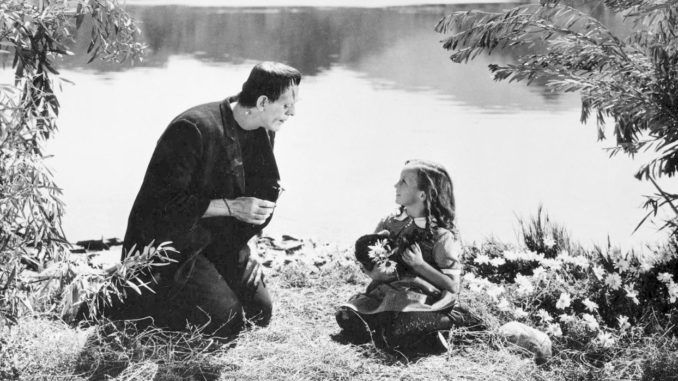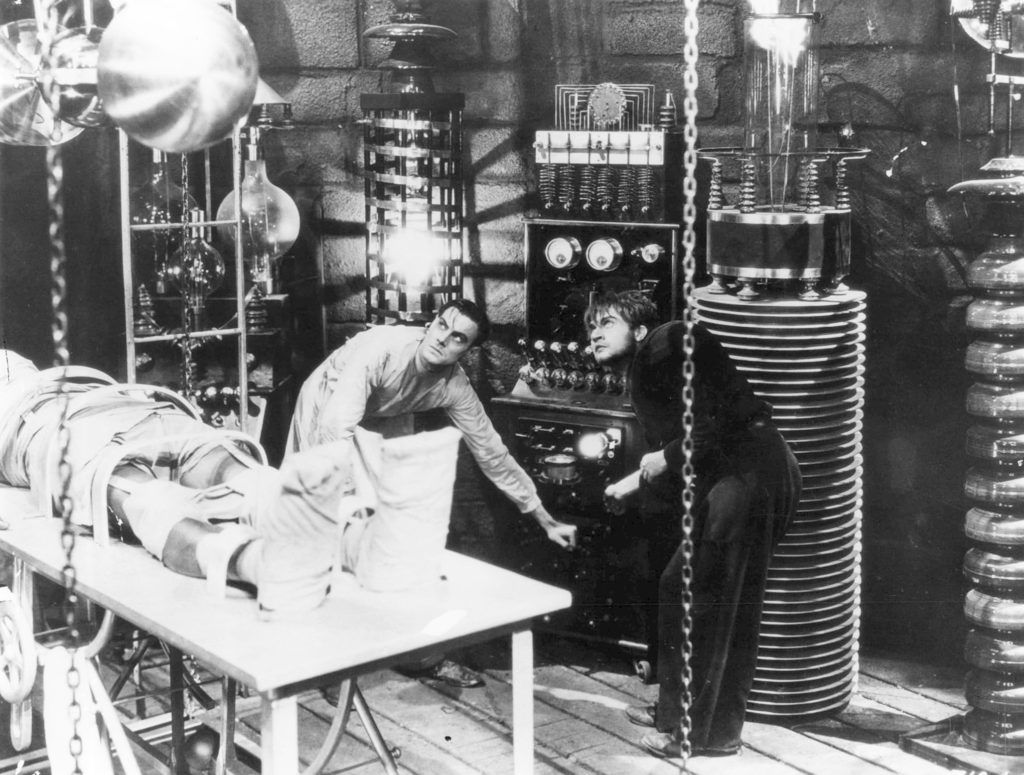
Rating: C
Dir: James Whale
Star: Colin Clive, Mae Clarke, John Boles, Boris Karloff
Likely fair to call 1931 the first golden year of the horror genre. It gave us not only this, but also two versions of Dracula, in English language and Spanish, plus Dr. Jekyll and Mr. Hyde. The last would have been a worthy champion in almost any other year. It won Frederic March the Best Actor Oscar, something not done by another horror film for sixty years (and that depends on whether you consider Silence of the Lambs in the genre). All of those films are rated 7.0 or better on the IMDb, with several thousand votes, and are widely recognized now as classics. If you’re feeling genre-expansive, you could perhaps add Barbara Stanwyck’s Night Nurse, another rated a seven, which the IMDb calls a Comedy, Crime, Drama, Horror and Mystery movie.
I was surprised to learn that Frankenstein is not a direct adaptation of Mary Shelley’s novel – even then, in the public domain, but is several generation removed. It was originally based on a stage version of the book, Frankenstein: An Adventure in the Macabre, written by British playwright Peggy Webling. This had premiered in, of all places, Preston, Lancashire, in December 1927. The production then toured for two years before running for 72 performances in London’s West End. Writer John Balderston was commissioned to adapt it for Broadway: while that never came to pass, it inspired the script for the movie. Balderston had similarly written a stage version of Dracula, which was also used as the basis for that film’s script. In Webling’s version, the scientist names his creation after himself, perhaps triggering the long-running confusion as to who Frankenstein is.
 After the immense success of Dracula, which literally saved Universal, Bela Lugosi was very much in the spotlight. He wanted to play Henry Frankenstein – I’m not sure why the first name here was changed from the canonical Victor [The IMDb says that name sounded “too severe and unfriendly”]- but the studio were more inclined to cast Lugosi as the monster. However, it all became moot after original director Robert Florey, who had gone so far as to film a screen test with Lugosi as the creature, was replaced by Whale. Discarded director and star went off and made Murders in the Rue Morgue instead. Replacing Bela was William Henry Pratt, born at 36 Forest Hill Road, Peckham Rye. [Fun fact: Tony Clarke, who ran renowned cult store Psychotronic Video, lived in a flat at the address during the 80’s, with two nurses and a trainee dentist, which sounds like a hilarious sit-com premise. He remembers, “We did often wonder why groups of men would gather across the road and take pictures. We just assumed it was because of the nurses.”]
After the immense success of Dracula, which literally saved Universal, Bela Lugosi was very much in the spotlight. He wanted to play Henry Frankenstein – I’m not sure why the first name here was changed from the canonical Victor [The IMDb says that name sounded “too severe and unfriendly”]- but the studio were more inclined to cast Lugosi as the monster. However, it all became moot after original director Robert Florey, who had gone so far as to film a screen test with Lugosi as the creature, was replaced by Whale. Discarded director and star went off and made Murders in the Rue Morgue instead. Replacing Bela was William Henry Pratt, born at 36 Forest Hill Road, Peckham Rye. [Fun fact: Tony Clarke, who ran renowned cult store Psychotronic Video, lived in a flat at the address during the 80’s, with two nurses and a trainee dentist, which sounds like a hilarious sit-com premise. He remembers, “We did often wonder why groups of men would gather across the road and take pictures. We just assumed it was because of the nurses.”]
But as well as Karloff, an absolutely key element is Jack Pierce’s make-up, which remains absolutely iconic. When people imagine Frankenstein, it’s still the look pioneered here, with a square head, bolts through the neck, etc. You can compare and contrast the weak effort in Hammer’s version of the story, where Christopher Lee looks more like has been attacked by a swarm of bees, and realize just how brilliant Pierce’s design was. It means Karloff spent three hours each morning in the make-up chair, typically arriving on set at 3:30 am, in order to be ready for the start of shooting, and another 90 minutes getting it removed at the end of the day. Little wonder that Boris sometimes would sleep with it on, supposedly bracing his head between books to stop him from damaging it in his sleep. Ironically, the bolts left him with life-long scars on his neck.
While there is no denying its status as one of the foundations of the genre, I found this a bit underwhelming. Despite a relatively brief running time of seventy-one minutes, it feels like there’s a fair amount of padding. For example, all the largely uninteresting faffing around, concerning the wedding of Henry Frankenstein (Clive), which the monster crashes – how, exactly, did he know where his creator lived? I was also not particularly impressed with Clive here, who seems a perspiring lunatic from the first frame, and a far less effective embodiment of the character than Peter Cushing’s calculating scientist in the Hammer franchise. I say both Bride of Frankenstein, and even Son of Frankenstein, are superior, doing a better job of building on the (admittedly groundbreaking, in some ways) foundations laid by this film.

It may be a problem that we don’t meet Henry until well into the movie, and his creation comes to life only at the half-way point. The subsequent movies were better able to hit the ground running, and feel better-paced to a modern audience. Once things get going, I could appreciate things a bit more. The re-animation sequence, showcasing electrical equipment assembled by Ken Strickfaden, is fab, culminating in Frankenstein’s pronouncement, “It’s alive! It’s alive!” I’d say it is one of the few points where Clive’s twitchy, near-manic performance, perhaps more suited to the theatre, actually pays off. It doesn’t feel particularly complex or sympathetic. The line (cut for post-Hays Code re-releases), “Now I know what it’s like to be God!”, is hardly endearing, yet is an accurate summary of his character’s interests.
The finale, where the angry villagers chase the monster into a windmill and set it on fire, may be the origin of another classic horror trope: the mob with torches and pitch-forks. [I’d probably have to check The Hunchback of Notre Dame to confirm that] Though I’m not certain I could see any of the latter present, to be honest. I would say this needs to be filed alongside the likes of Night of the Living Dead. For this is a film whose position in genre history is utterly secure. Yet I will argue, others would go on to harvest greater things, from the land discovered by Whale as an explorer of new cinematic terrain.
This article is part of our October 2025 feature, 31 Days of Vintage Horror.
